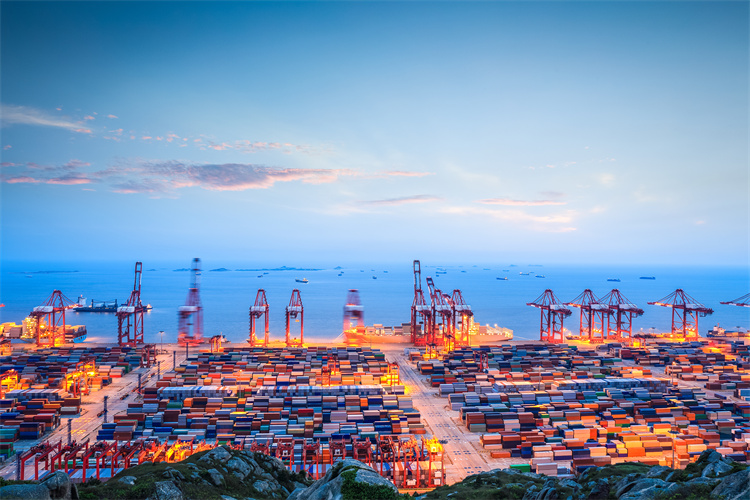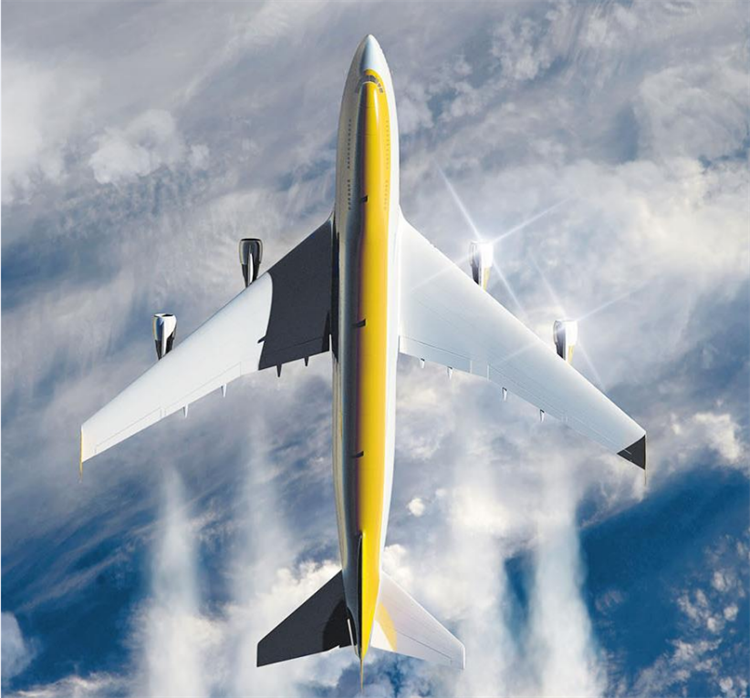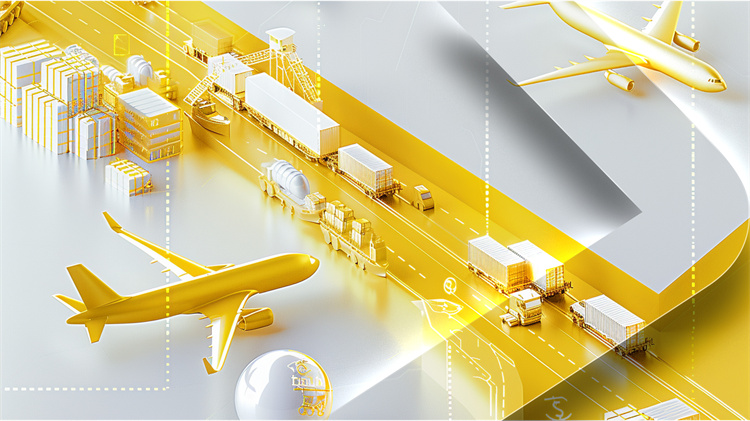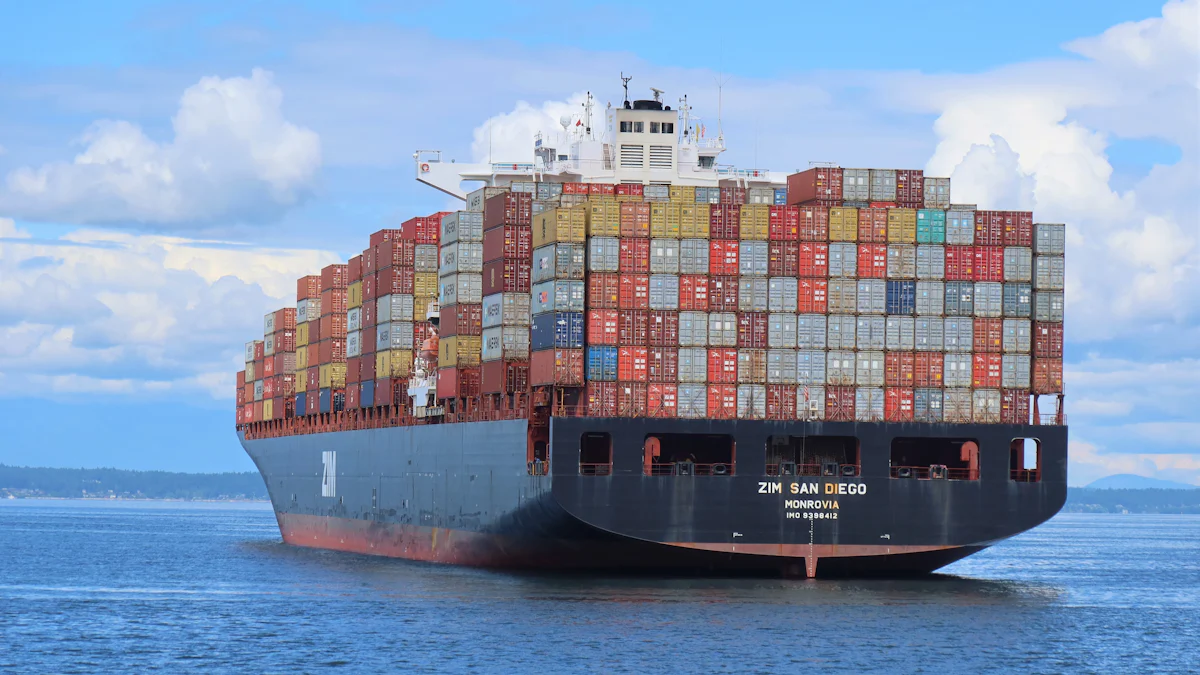Air and Sea Transport: A Path to Better Logistics

Air and sea transportation plays a crucial role in global logistics. Maritime transportation handles approximately 90% of global merchandise, highlighting its importance in international trade. Air cargo, on the other hand, moves goods worth over $6 trillion annually, accounting for about 35% of global trade by value. These modes of transport offer significant potential for improvement in logistics. The logistics industry, valued at over 8.4 trillion euros in 2021, is expected to exceed 13.7 billion euros by 2027. Enhancing air and sea transportation can further boost this industry's growth and efficiency.
Understanding Air and Sea Transportation

Basic Concepts of Air Transport
Air transport serves as a vital component in global logistics. The industry facilitates the movement of goods swiftly across continents. Airline companies specialize in transporting passengers and cargo, ensuring timely deliveries. SkyTeam Cargo, an alliance of cargo airlines, enhances product deliverability worldwide. UPS Inc. and FedEx Corp. lead the freight carrier market, each generating over 70 billion U.S. dollars in freight revenues.
Types of Air Cargo
Air cargo can be categorized into general cargo and special cargo. General cargo includes consumer electronics and textiles. Special cargo requires specific handling due to its nature. This category includes perishable goods, hazardous materials, and live animals. The choice of air cargo type impacts the logistics strategy and cost.
Key Players in Air Transport
Several key players dominate the air transport sector. Airline companies play a crucial role by providing the necessary infrastructure and services. SkyTeam Cargo offers extensive network coverage for efficient deliveries. UPS Inc. and FedEx Corp. ensure reliable freight services globally. These companies contribute significantly to the efficiency of air logistics.
Basic Concepts of Sea Transport
Sea transport forms the backbone of international trade. This mode of transport handles approximately 90% of global merchandise. The industry relies on large vessels to move goods across oceans. Kuehne + Nagel ranks among the top ocean freight forwarders by volume. DB Schenker and DSV also hold significant positions in the market.
Types of Sea Cargo
Sea cargo includes containerized cargo, bulk cargo, and breakbulk cargo. Containerized cargo involves goods packed in containers for easy handling. Bulk cargo consists of unpackaged goods like grains and coal. Breakbulk cargo refers to goods transported in smaller units. Each type of sea cargo requires specific handling and storage solutions.
Key Players in Sea Transport
Key players in sea transport include Kuehne + Nagel, DB Schenker, and DSV. These companies excel in managing ocean freight operations. DHL provides quicker and easier solutions for sea transportation. The global e-commerce logistics market, valued at 441 billion euros in 2021, benefits from these companies' expertise. Their contributions enhance the efficiency of sea logistics.
Importance of Coordination in Logistics
Coordination Between Air and Sea Transportation
Coordination between air and sea transportation enhances logistics efficiency. Integrated logistics combines the strengths of both modes. Air freight offers speed for high-value, time-sensitive shipments. Sea freight provides cost-effectiveness for large, bulky, or non-urgent shipments. A well-coordinated system optimizes these benefits, ensuring timely and economical delivery.
Benefits of Integrated Logistics
Integrated logistics reduces greenhouse gas emissions. Multimodal freight, which uses both air and sea transportation, decreased emissions by 25% compared to single-mode transport in 2021. This approach also improves supply chain agility. Businesses can choose the best mode based on shipment needs. Air and sea transportation coordination leads to better resource utilization and environmental sustainability.
There is a logistics supply chain technology company that has a strong advantage in the convenience of air freight JUSDA:
Mature and Rich Route Network: JUSDA has established routes such as China-Mexico-US and Vietnam-US, with plans for new routes like China-India. This extensive network ensures broad coverage and flexibility.
Three-Stage Consolidation Service: This service optimizes airfreight costs by flexibly utilizing Block Space Agreements (BSA) and external resources, adapting to seasonal fluctuations.
Efficient Operational Capabilities: JUSDA delivers efficient operations at both main gateway airports and inland airports, ensuring smooth handling and transit of goods.
Combination of Own Capacity and Partner Resources: By leveraging its own capacity along with partner resources, JUSDA ensures fast and secure air freight services globally.
Route Planning and Resource Allocation: JUSDA accurately plans principal routes and adjusts airfreight resource structures based on market demand and cargo volume characteristics. This includes utilizing BSAs combined with outsourced resources to lower air freight costs.
Service Strengthening and Upgrade: At inland airports, JUSDA benefits from government subsidies and low-cost advantages, reducing costs through land-air or air-air intermodal transportation. They also enhance ground handling capabilities at gateway airports and improve door-to-door services abroad.
Product Innovation and Expansion: JUSDA develops standard air freight products for routes like China-India and China-Europe and plans to launch new transnational and regional routes. They also consider organizing airfreight return cargoes to strengthen their competitive edge.
On-time Delivery and Flexibility: JUSDA offers daily flights with fixed schedules and flexible billing options, ensuring timely delivery and efficient service for various logistics needs.
These advantages collectively make JUSDA's air freight services highly efficient, cost-effective, and reliable for global logistics.

SMART JusLink
Supply Chain Management Solution
Challenges in Coordination
Challenges exist in coordinating air and sea transportation. Different transit times require precise scheduling. Efficient local transportation solutions are necessary for cargo transfer between port and airport terminals. Freight forwarders play a crucial role in managing these complexities. Advanced technology and real-time visibility tools enhance coordination efforts. These tools ensure smooth transitions and minimize delays.
Role of Coordination in Supply Chain Efficiency
Coordination in logistics impacts supply chain efficiency significantly. Air and sea transportation must align to maximize performance. Proper coordination ensures that goods move seamlessly through the supply chain. This alignment affects delivery times and costs.
Impact on Delivery Times
Delivery times improve with effective coordination. Air transportation speeds up the movement of urgent goods. Sea transportation handles bulk shipments efficiently. Coordinated efforts reduce transit times. Businesses meet customer expectations by delivering products promptly. Air and sea transportation integration allows for flexible scheduling and faster deliveries.
Cost Implications
Cost implications arise from coordination between air and sea transportation. Businesses save money by choosing the most suitable mode for each shipment. Air transportation incurs higher costs due to speed and convenience. Sea transportation offers lower shipping costs per item or unit weight. A balanced approach reduces overall logistics expenses. Companies achieve cost-effectiveness by leveraging both air and sea transportation.
Practical Strategies for Optimization
Route Optimization
Route optimization plays a crucial role in logistics. Businesses must consider several factors when selecting routes. These factors include distance, cost, and time. Weather conditions and geopolitical stability also affect route selection. Companies need to evaluate these elements to ensure efficient logistics operations.
Factors Affecting Route Selection
Distance: Shorter routes often lead to reduced fuel consumption.
Cost: Toll fees and tariffs can impact the overall transportation cost.
Time: Delivery deadlines require careful planning of transit times.
Weather Conditions: Adverse weather can cause delays and rerouting.
Geopolitical Stability: Political unrest can disrupt supply chains.
Businesses must analyze these factors to optimize logistics routes effectively. A beverage corporation optimized its supply chain by evaluating these elements. The company reduced costs and improved service levels.
Tools for Route Optimization
Several tools assist in route optimization. GPS technology provides real-time location tracking. Businesses use software solutions to calculate optimal routes. These tools consider traffic patterns and road conditions. Companies can also use data analytics to predict demand fluctuations. Predictive analytics helps in planning efficient routes.
Case Study: A UK manufacturer modernized its supply chain using advanced tools. The company improved logistics efficiency by leveraging technology. This approach helped the business meet dynamic industry demands.
Load Optimization
Load optimization enhances cargo space utilization. Businesses aim to maximize the use of available space. Efficient load management reduces transportation costs. Companies must balance load capacity with safety regulations.
Techniques for Maximizing Cargo Space
Stacking: Proper stacking techniques prevent damage and maximize space.
Packaging: Compact packaging reduces the volume of goods.
Palletization: Using pallets organizes cargo efficiently.
Weight Distribution: Even weight distribution ensures vehicle stability.
These techniques help businesses optimize cargo loads. A logistics company recognized the importance of asset availability. The company improved production capacity utilization through effective load management.
Balancing Load and Safety
Safety remains a priority in load optimization. Overloading vehicles can lead to accidents. Businesses must adhere to weight limits and safety standards. Proper securing of cargo prevents shifting during transit. Companies should invest in training for safe loading practices.
Case Study: A logistics firm unearthed profitability by optimizing load and safety. The firm reduced operating costs while maintaining high service levels. This balance ensured efficient and secure logistics operations.
Leveraging Technology in Logistics
Air and sea transportation benefit greatly from technological advancements. Automation and data analytics play pivotal roles in enhancing logistics operations. These technologies drive efficiency and optimize processes.
Use of Automation
Automation transforms air and sea transportation. Automation transforms air and sea transportation. Automated systems streamline operations and reduce human error. Logistics companies achieve faster and more reliable services.
Automated Systems in Air Transport
Automated systems in air transport enhance efficiency. Airlines use automated cargo handling to speed up loading and unloading. Automated systems improve accuracy in inventory management. Robotics assist in sorting and tracking packages. Automation reduces labor costs and increases throughput.
Automated Systems in Sea Transport
Sea transport also benefits from automation. Ports implement automated cranes for container handling. Automated systems optimize vessel scheduling and berthing. Shipping companies use automated navigation for route planning. Automation ensures timely departures and arrivals. These systems enhance the reliability of sea transportation.
Role of Data Analytics
Data analytics revolutionizes air and sea transportation. Companies use data to make informed decisions and predict trends. Analytics tools provide insights into supply chain performance.
Predictive Analytics for Demand Forecasting
Predictive analytics plays a crucial role in demand forecasting. Logistics companies analyze historical data to anticipate future demand. Predictive models help in inventory management and resource allocation. Accurate forecasts prevent overstocking and stockouts. Companies maintain a balance between supply and demand.
Real-time Tracking and Monitoring
Real-time tracking enhances air and sea transportation. GPS technology provides live updates on cargo location. Companies monitor shipments throughout the journey. Real-time data ensures transparency in logistics operations. Customers receive accurate delivery estimates. This technology improves customer satisfaction and trust.
Scientific Research Findings:
Data Analytics and Automation in Logistics: Data analytics paired with automation technology and the Internet of Things may completely automate the logistics industry.
AI Impact on Logistics Efficiency: AI is expected to make supply chains 45% more effective in delivering products on time and without errors.
Air and sea transportation continue to evolve with technology. Automation and data analytics offer competitive advantages. Companies leverage these tools to enhance logistics efficiency. The integration of technology ensures a seamless flow of goods across borders.
Future Trends in Air and Sea Transport

Sustainable Practices
Green Technologies in Air Transport
Air and sea transportation face increasing pressure to adopt sustainable practices. Green technologies in air transport focus on reducing carbon emissions. Airlines invest in energy-efficient aircraft. These aircraft consume less fuel and emit fewer pollutants. The use of biofuels also contributes to greener air travel. Biofuels reduce the carbon footprint of flights. Airlines implement these innovations to meet environmental standards.
Eco-friendly Innovations in Sea Transport
Sea transport also embraces eco-friendly innovations. Shipping companies invest in low-carbon fuels. Low-carbon fuels decrease emissions from vessels. The introduction of renewable fuels supports this transition. Renewable fuels blend with traditional fuels to lower emissions. Ships use energy-efficient engines to conserve fuel. These engines enhance the sustainability of sea transportation. Sustainable transport systems benefit communities by improving environmental quality.
Emerging Technologies
Impact of AI and Machine Learning
Emerging technologies transform air and sea transportation. AI and machine learning optimize logistics operations. These technologies improve route planning and cargo management. AI analyzes data to predict demand and supply trends. Machine learning enhances decision-making processes. Logistics companies use AI to automate tasks. Automation reduces human error and increases efficiency. AI-driven systems streamline air and sea transportation.
Blockchain in Logistics
Blockchain technology revolutionizes logistics management. Blockchain provides secure and transparent transaction records. This technology enhances trust in air and sea transportation. Companies use blockchain to track shipments in real-time. Real-time tracking improves visibility across supply chains. Blockchain reduces fraud and errors in logistics operations. The integration of blockchain ensures reliable and efficient transportation. Air and sea transportation benefit from these technological advancements.
Measuring Performance in Logistics
Measuring performance in logistics involves assessing various aspects of air and sea transportation. Key performance indicators (KPIs) provide valuable insights into operational efficiency and customer satisfaction. Continuous improvement strategies ensure that logistics operations remain competitive and effective.
Key Performance Indicators (KPIs)
KPIs serve as essential tools for evaluating the success of air and sea transportation. These indicators help identify areas for improvement and track progress over time.
Efficiency Metrics
Efficiency metrics focus on the operational aspects of logistics. Companies measure the speed and accuracy of air and sea transportation. Metrics include transit times, delivery accuracy, and cost-effectiveness. Efficient logistics operations reduce costs and enhance service quality. The integration of AI in multimodal transport systems can potentially reduce logistics costs by up to 20%.
Transit Times: Measure the time taken for goods to move from origin to destination.
Delivery Accuracy: Assess the precision of deliveries in meeting scheduled times.
Cost-Effectiveness: Evaluate the cost incurred per shipment or unit weight.
Customer Satisfaction Metrics
Customer satisfaction metrics assess the quality of service provided by air and sea transportation. These metrics reflect the customer's experience and perception of logistics services. High customer satisfaction indicates successful logistics operations.
On-Time Delivery: Measure the percentage of shipments delivered on schedule.
Service Quality: Evaluate the level of service provided to customers.
Customer Feedback: Collect and analyze feedback to identify areas for improvement.
Continuous Improvement Strategies
Continuous improvement strategies focus on enhancing the performance of air and sea transportation. These strategies involve regular assessment and adaptation to changing market demands.
Feedback Loops
Feedback loops play a crucial role in continuous improvement. Companies gather data from various sources to evaluate logistics performance. Feedback from customers and stakeholders provides insights into areas needing improvement. Regular analysis of feedback helps refine logistics processes.
Customer Surveys: Conduct surveys to gather customer opinions on service quality.
Performance Reviews: Regularly review logistics operations to identify inefficiencies.
Data Analysis: Analyze collected data to uncover trends and patterns.
Benchmarking Against Industry Standards
Benchmarking involves comparing logistics performance against industry standards. Companies use benchmarking to identify best practices and set performance goals. This process ensures that air and sea transportation remains competitive and efficient.
Industry Comparisons: Compare logistics metrics with industry averages.
Best Practices: Identify and implement best practices from leading logistics providers.
Performance Goals: Set achievable goals based on industry benchmarks.
Continuous improvement in logistics requires a commitment to excellence. By measuring performance and implementing improvement strategies, companies enhance the efficiency and effectiveness of air and sea transportation. This approach ensures that logistics operations meet the evolving needs of global trade.
Air and sea transportation significantly enhance logistics by offering unique advantages. Air freight ensures quick delivery for high-value goods. Sea freight provides a sustainable option for non-urgent shipments. The combination of air and sea transportation, known as Air-Sea shipping, offers cost savings and reasonable shipping times. Technological advancements play a crucial role in shaping the future of logistics. Automation and data analytics optimize operations. Continuous performance measurement remains essential for sustained improvement. Businesses must adapt and innovate to meet evolving demands. Air and sea transportation will continue to drive global trade efficiency.
See Also
2024: The Latest Trends in Ocean Freight Logistics
Tomorrow's Logistics Revolution: AI in the Supply Chain
Future Exploration: Breakthroughs in Logistics Technology
